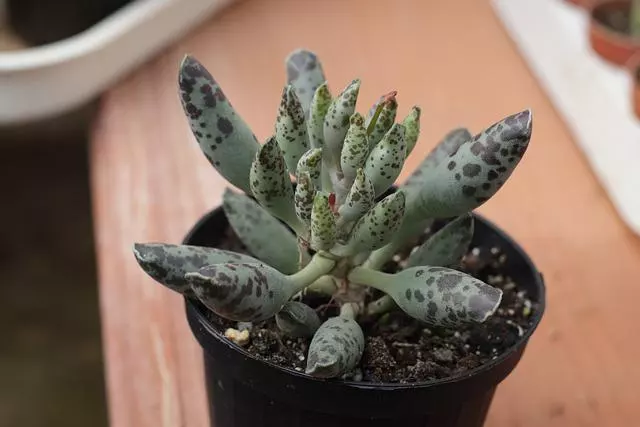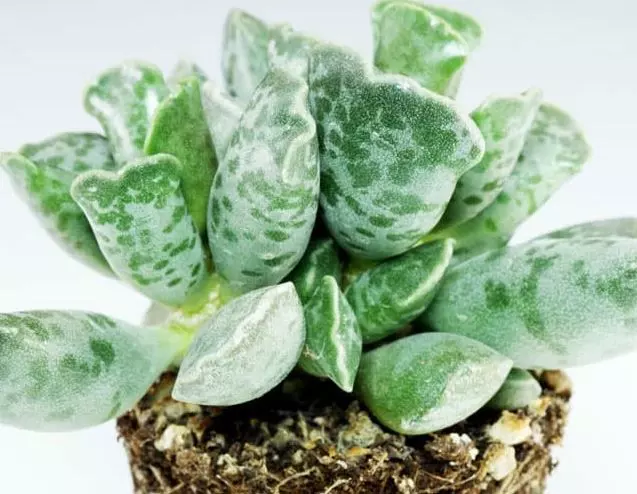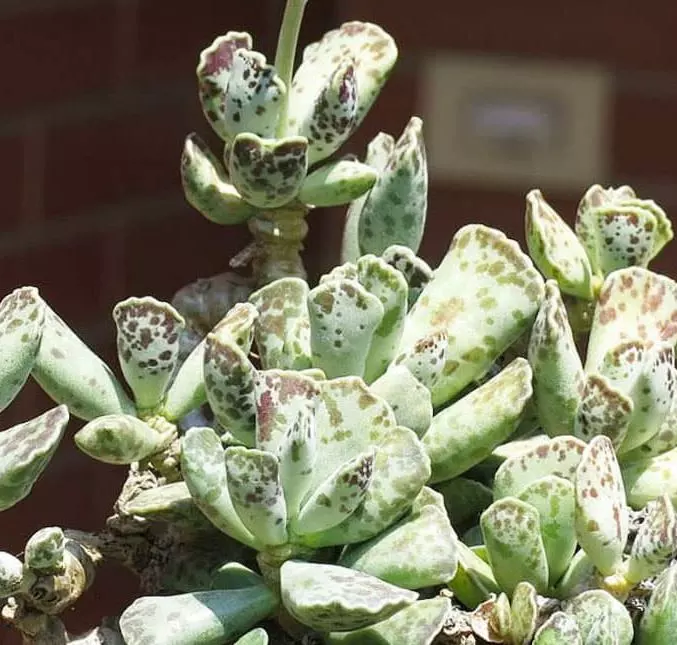Adromischus cooperi is a very showy succulent plant thanks to its nice reddish speckles that go very well in any home garden. Learn all about Adromischus cooperi care. In addition, in the section “Adromischus cooperi propagation” you will find a step-by-step guide that explains in detail How to Propagate Adromischus cooperi and how to take care of Adromischus cooperi plant until it becomes an adult succulent plant.
Let’s start with the most complete guide about Adromischus cooperi care and propagation.

Table of Contents
Characteristics of Adromischus cooperi
Adromischus cooperi is a dwarf succulent plant, perennial in nature, between 0.8” and 2.75” (2 and 7 cm) in height and 6” (15 cm) in extension.
The leaves are very fleshy, narrow at the base, with a very particular curved shape at the end. These leaves have a pale green color but are filled with reddish specks when they receive direct sun.
Adromischus cooperi is native to the eastern cape of South Africa, although today it can be found in homes all over the world.
This plant has small tubular flowers with a mixture of pinkish, purple, and white colors.
Despite its small size, the Adromischus cooperi flower can grow on an upright stem more than 12” (30 cm) high.
Adromischus cooperi Care
Adromischus cooperi Care. Like other plants of the Crassulaceae family, taking care of Adromischus cooperi is very simple, just let’s review a few tips.
Adromischus cooperi is not a very large plant, in fact, the maximum height it can reach is about 10 centimeters.
Adromischus cooperi Care – Lighting and Temperature
Adromischus cooperi is a plant that needs a lot of light (at least 8 hours a day). although direct exposure to sunlight should be avoided, as it can damage the leaves and cause wrinkles, which is a sign of suffering.
In summer, when the temperature exceeds 24 degrees, the plant can be placed outdoors, and in winter it should not be placed in places where the temperature drops below 5 degrees, taking care not to leave the plant in direct exposure to rain, which could be fatal.
The ideal temperature for Adromischus cooperi Care. Being mostly native to very warm countries, they prefer warmth to cold, although they have not shown special adaptation problems. In fact, there are some varieties that can withstand periods, albeit brief, of frost. However, in general, succulent plants vegetate well at temperatures of about 20 °C.
It is a plant that needs direct sunlight and withstands perfectly in dry climates. But do not panic if you notice a “shrinking” of the leaves during these times, as they return to their normal state with watering.
During the cold seasons, it should be in a dry environment with a temperature between 50°F and 59°F (10 °C and 15 °C).
Adromischus cooperi Care – Fertilization
Adromischus cooperi Care – Fertilization. There are fertilizers on the market specially designed to fertilize succulent plants (learn more in this article).
In general, it is necessary to fertilize twice a year at the doses recommended by the product.
Adromischus cooperi Care – Watering
- Summer: generous watering, but the substrate should dry out completely between watering.
- Winter: Spaced watering every 2 weeks or so. Always make sure that the substrate is completely dry before watering.
Cleaning Adromischus cooperi
Cleaning Adromischus cooperi. Clean the succulent leaves with a damp cloth once a month.
Leaves: The junction of the leaves is very sensitive and can fall off at the slightest touch. Handle the plant with care.
Pest Control – Adromischus cooperi Care
Pest Control – Adromischus cooperi can be attacked by mealybugs or rot due to overwatering.

How to Grow Plover Eggs Plant
This succulent blooms in spring and grows in autumn/winter, i.e. it puts out new leaves.
For the soil base, it is advisable to use a special substrate for cacti and succulents. Fortunately, these are readily available in any store nowadays.
Adromischus cooperi Propagation
Adromischus cooperi Propagation. Like other succulents of the family, Adromischus cooperi can be propagated from a single leaf of the original plant.
The succulent plant Adromischus cooperi is easily propagated by leaf cuttings. Adromischus cooperi propagation is very simple and similar to the propagation of other succulents.
Adromischus cooperi Propagation Step-by-Step
Let’s continue reading in detail to learn how to propagate Adromischus cooperi Step-by-Step.
- Prepare a pot with the right substrate for Adromischus.
- The best substrate for Adromischus cooperi should contain soil composed of dry leaves and peat, with a little sand, which will be essential for water drainage and to avoid dangerous stagnation.
- To propagate Adromischus cooperi you only need to cut a healthy leaf with a sharp knife previously disinfected.
- Then, let the wound dry for a couple of days before transferring it to the soil.
- After a few days, place the leaf cut from the mother plant in a pot with succulent soil, helping it to maintain its upright position with gravel placed on the sides of the leaf.
- Only the cut end should be in contact with the soil, otherwise, if the leaf gets in contact with the moist soil it will quickly rot.
- During the Adromischus cooperi propagation it is advisable to place the pot in a good location with access to light. They adapt well to very unnatural light conditions, drafts, and temperature fluctuations. However, high exposure to heat is not advisable. In summer they can be moved to a cooler location.
- Note that Adromischus cooperi does not need much water. So this propagated Adromischus leaf, which has not even developed roots yet, will not need much water either. It is key to the success of Adromischus cooperi propagation not to overwater, as it will easily rot.
- ✔ Small Size with Large Capacity: Only 6.3" Tall 3" Diameter with 200ml, enough for indoor plants like succulents or herbs.It is the best present for plants lover.
- ✔ Multi-application: Lightweight and multi-function, this plant mister can be used for general spraying both indoor and outdoor, gardening, general cleaning, and many more other applications.
- ✔ Material: The top pump is made of plastic which prevent rust, and the spray bottle is made of thickened glass, not easily broken.
When is the Best Time to Propagate Adromischus cooperi?
When is the Best Time to Propagate Adromischus cooperi? The best time to propagate Adromischus cooperi is during spring and summer.
During the winter, the root system of Adromischus cooperi is dormant and while it is possible to propagate Adromischus, it may be slower to develop roots and will require more care until the leaf develops into a plant.
Also in winter watering of the mother plant is reduced to twice a month, so watering of the propagating Adromischus cooperi leaf may only require a few drops of water and can be done drop by drop irrigation.
Repotting Adromischus cooperi
Repotting Adromischus cooperi. The growth of Adromischus cooperi is relatively slow, so repotting should only be done when the size of the plant exceeds the size of the pot.
Watering Adromischus cooperi After Propagation
Watering Adromischus during the winter is reduced to twice a month and in spring and summer once every seven to ten days.
The amount of water distributed should, in general, wet the entire soil evenly without stagnation. The best procedure is to water the soil directly from above.
As for watering, keep the substrate moist (without puddling) for the first 10 weeks. From then on, we follow the usual care of this plant, always letting the substrate dry between waterings.
Now, be patient. It is a plant that has slow growth and due to the fragility of its leaves, it can take an eternity to have a complete specimen.
Is Adromischus cooperi Toxic to Cats and Dogs?
Is Adromischus cooperi Toxic to Cats and Dogs? Although no official ASPCA or scientific information is available to support its toxicity, the succulent plant may have some toxic to dogs and cats in the same way that other succulents of the same family Crassulaceae have toxic effects on cats and dogs causing vomiting and drunkenness (cats).



